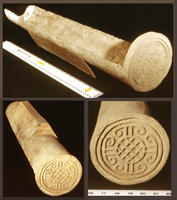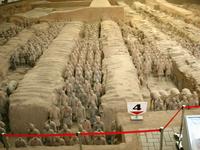You are in: Asia -> China -> Mausoleum of the Fir... , and traditional search or Image Gallery will yield results of this site only
Mausoleum of the First Qin Emperor
| Site number: | 441 |
|
| Type of site: | Cultural | |
| Date: | 200 BC | |
| Date of Inscription: | 1987 | |
| Location: | Asia, China, Lintong County, Shaanxi Province | |
| Video: |
|
Up to 75 images are shown here. Click on each for more details or on Image Gallery for more images.
Six official UN languages:
Arabic,
Chinese,
English,
French,
Russian,
Spanish
Other languages: Croatian, Dutch, Esperanto, Finnish, German, Hebrew, Indonesian, Italian, Japanese, Norwegian-bokmål, Polish, Portuguese, Serbian, Swedish, Thai, Vietnamese
Other languages: Croatian, Dutch, Esperanto, Finnish, German, Hebrew, Indonesian, Italian, Japanese, Norwegian-bokmål, Polish, Portuguese, Serbian, Swedish, Thai, Vietnamese
| Description: | This archaeological site, which was not discovered until 1974, still holds thousands of unexcavated statues. The design of the complex mirrors the urban plan of the capital Xianyan; at its centre Qin (d. 210 B.C.), the first unifier of China, lies buried, surrounded by the famous terracotta warriors. Masterpieces of realism and also of great historical interest, the small figures are all different; with their horses, chariots and weapons. --WHMNet paraphrase from the description at WHC Site, where additional information is available. For 360 degree imaging of this site, click here. | |
| The Terracotta Army (traditional Chinese: 兵馬俑; simplified Chinese: 兵马俑; pinyin: bīngmǎ yǒng; literally "soldier and horse funerary statues") or Terracotta Warriors and Horses is a collection of 8,099 larger-than-life Chinese terra cotta figures of warriors, horses, acrobats and other figures located near the Mausoleum of the First Qin Emperor (Chinese: 秦始皇陵; pinyin: Qín Shǐhuáng líng). The figures vary in height, according to their role, the tallest being the Generals. The heights range is 184–197cm (6ft–6ft 5in) or more than a full foot taller than the average soldier of the period. The figures were discovered in 1974 near Xi'an, Shaanxi province, China by several local farmers.It is also said that an army attacked China, but upon seeing the Terracotta army near completion, fled in terror. The Terracotta Army was buried with the Emperor of Qin (Qin Shi Huangdi) in 209-210 BC (his reign over Qin was from 247 BC to 221 BC and unified China from 221 BC to the end of his life in 210 BC). Their purpose was to help rule another empire with Shi Huangdi in the afterlife. Consequently, they are also sometimes referred to as "Qin's Armies". Some people think that the army was also built for protection. Construction of this mausoleum began in 246 BC and is believed to have taken 700,000 workers and craftsmen 36 years to complete. Qin Shi Huangdi was interred inside the tomb complex upon his death in 210 BC. According to the Records of the Grand Historian by Sima Qian (145 BC-90 BC), the First Emperor was buried alongside great amounts of treasure and objects of craftsmanship, as well as a scale replica of the universe complete with gemmed ceilings representing the cosmos, and flowing mercury representing the great earthly bodies of water. Pearls were also placed on the ceilings in the tomb to represent the stars, planets, etc. Recent scientific work at the site has shown high levels of mercury in the soil of Mount Lishan, tentatively indicating an accurate description of the site’s contents by historian Sima Qian. The tomb of Qin Shi Huangdi is near an earthen pyramid 76 meters tall and nearly 350 square meters. The tomb presently remains unopened. There are plans to seal off the area around the tomb with a special tent-type structure to prevent corrosion from exposure to outside air. However, there is at present only one company in the world that makes these tents, and their largest model will not cover the site as needed. --Wikipedia. Text is available under the Creative Commons Attribution-ShareAlike License. For 360 degree imaging of this site, click here. | ||
| Source: | http://whc.unesco.org/en/list/441 | |
| Source2: | http://whc.unesco.org/en/list/441/video | |
| Source3: | http://memorynet.org | |
| Reference: | 1. UNESCO World Heritage Center, Site Page. 2. Ching-chih Chen's Global Memory Net. | |


 Videos from The First Empreor of China by Ching-chih Chen
Videos from The First Empreor of China by Ching-chih Chen









































































